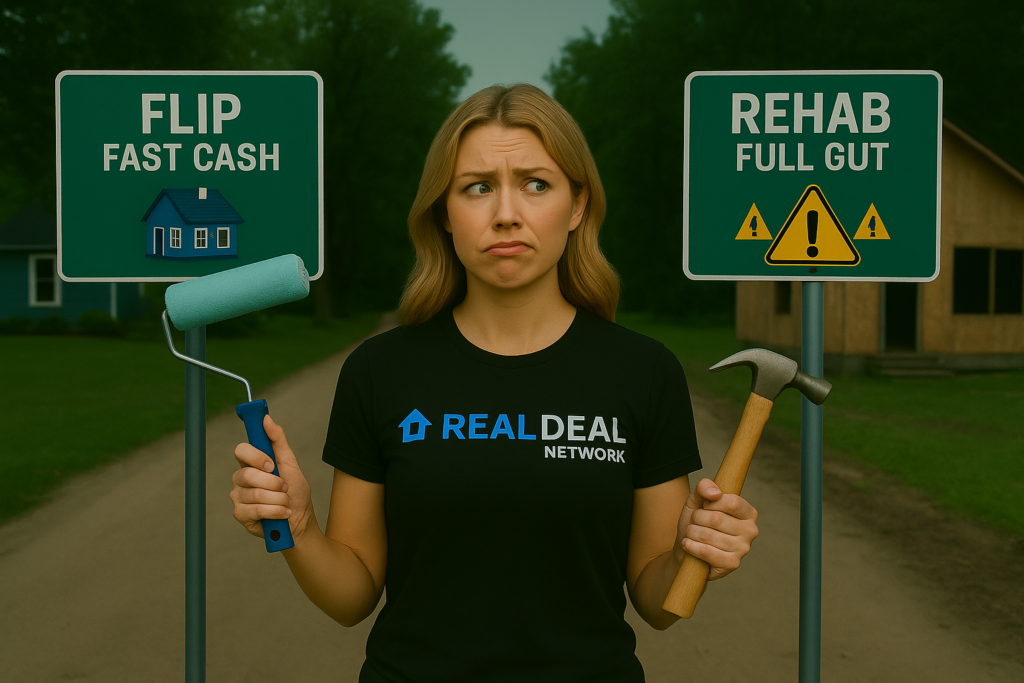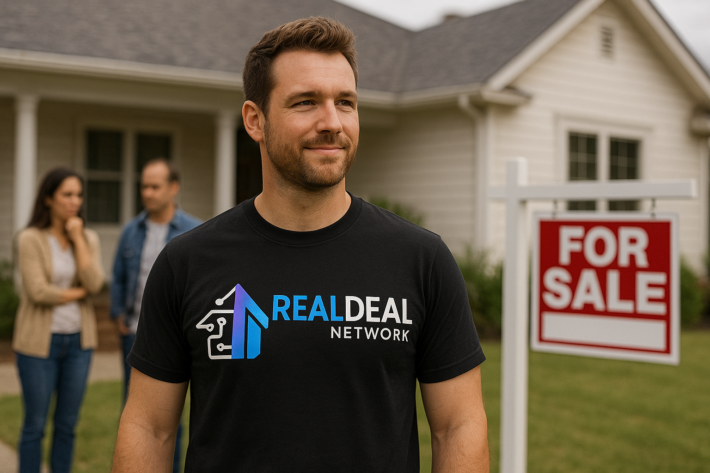Flip or Rehab? Know the Difference Before You Swing a Hammer

Flips are cosmetic. Rehabs are critical. Confuse them, and it’ll cost you.
Let’s clear something up:
Not all renovations are created equal.
There’s a big difference between a flip and a rehab… and if you don’t know which one you’re doing, your budget (and sanity) will disappear faster than a Home Depot sale on demo day.
Too many new investors think any property they fix and sell is a “flip.”
But here’s the real deal:
🛠️ A flip is lipstick.
🔧 A rehab is surgery.
🏡 First Up: What Is a Flip?
A flip (sometimes called a “light rehab”) focuses on cosmetics… the things that look outdated but are mostly functional underneath.
It’s about updating a property to boost resale value quickly and cleanly.
🧼 Typical Flip Fixes:
- Interior/exterior paint
- New flooring or carpet
- Light fixture upgrades
- Cabinet painting or refacing
- Replacing counters, sinks, hardware
- Landscaping or curb appeal touches
🕒 Timeline: 4–8 weeks
💰 Cost Range: $15K–$40K (avg)
📦 Materials: Mostly finish-level (paint, tile, trim)
🚫 What You Don’t Touch: Plumbing, electrical panels, HVAC, foundation
💡 Goal: Make it pretty and move it fast.
🧱 What Is a Rehab?
A rehab digs deep… literally.
You’re not just making a home prettier… you’re making it function properly again.
This often involves fixing deferred maintenance, structural issues, outdated systems, or even unsafe living conditions.
🔧 Typical Rehab Work:
- Roof replacement
- Full gut and rewire
- Plumbing replacement or rerouting
- HVAC or boiler systems
- Foundation cracks or structural beams
- Termite or water damage repair
- Mold remediation
- Wall removal, floor plan reconfiguration
- Major code compliance
🕒 Timeline: 3–6+ months
💰 Cost Range: $60K–$250K+ (depending on region and scope)
📦 Materials: Structural + finish level
✅ What You Touch: Everything… and then some
💡 Goal: Restore function and safety, then improve aesthetics.
📊 Flip vs. Rehab—Quick Comparison
| Category | Flip (Cosmetic) | Rehab (Structural) |
|---|---|---|
| Main Focus | Looks & livability | Functionality & longevity |
| Cost Range | $15K–$40K | $60K–$250K+ |
| Timeline | 1–2 months | 3–6+ months |
| Risk Level | Lower (if done right) | Higher (especially for beginners) |
| Permit Needs | Usually none or minor | Often requires full permitting process |
| Resale Strategy | Retail buyer, FHA-ready | FHA or investor-grade depending on market |
| Contractors | Handymen & subs | Licensed trades + project manager |
| Contingency Buffer | 10%–15% | 20%–30% minimum |
🧠 Why Knowing the Difference Can Save Your Deal
Here’s what happens when someone mistakes a rehab for a flip:
😬 They budget $25K… and spend $80K.
⏳ They plan for 30 days… and it drags on for 6 months.
💸 They skip permitting… and get red-tagged by the city.
😤 They price for top dollar… but the market demands fully updated systems.
🧯 They get burned out and barely break even—or lose money entirely.
💡 Pro Tips: How to Spot the Difference BEFORE You Buy
✅ Walk the major systems:
- Test the HVAC
- Check for double-tapped breakers in the panel
- Flush all toilets and run every faucet
- Look for water stains in the basement or ceiling
- Pop the attic… look for mold or outdated insulation
✅ Ask for the seller’s disclosure (if available)
Even in off-market deals, you can ask the owner about:
- Age of the roof
- Plumbing material (galvanized = red flag)
- Any past water intrusion
- Foundation shifts or cracks
✅ Budget buffer:
If you’re dealing with anything built pre-1980, assume it’s a rehab until proven otherwise. Vintage charm comes with vintage problems.
🧱 Not All Profits Are Equal
Here’s the catch:
- Flips are faster, but often less profitable… you’re targeting volume or quick cash flow.
- Rehabs can be more profitable, but carry higher risk and require deeper pockets and patience.
🎯 If you’re short on cash, experience, or a team… start with a flip.
📈 If you’ve got experience, systems, reserves, and education… a rehab might be your next wealth-building move.
🎓 Education = Protection
You wouldn’t jump into surgery without med school.
So why swing a hammer on a rehab without knowing:
- How to properly scope a job
- What red flags to look for during due diligence
- How to schedule trades so you don’t lose time
- How to avoid over-improving for the neighborhood
- How to calculate true holding and exit costs
🎓 Education turns confusion into confidence… and chaos into cash flow.
🧠 Bottom Line
A flip makes a house look good.
A rehab makes a house livable.
Both can make you money… but only if you know what you’re doing.
🏚️ Know your deal type.
📈 Know your numbers.
👷♀️ Know your lane.
The right strategy at the right time is what builds momentum in your investing journey.
📣 Ready to Learn What Type of Deal Fits YOU?
Join our next intro session and we’ll break down:
- The 3 types of deals every investor should understand
- How to spot red flags on a walk-through
- Real student stories (and how they learned the hard way… so you don’t have to)
💡 You don’t need to guess.
You need to know.
Let’s help you flip smart… and rehab like a pro.







